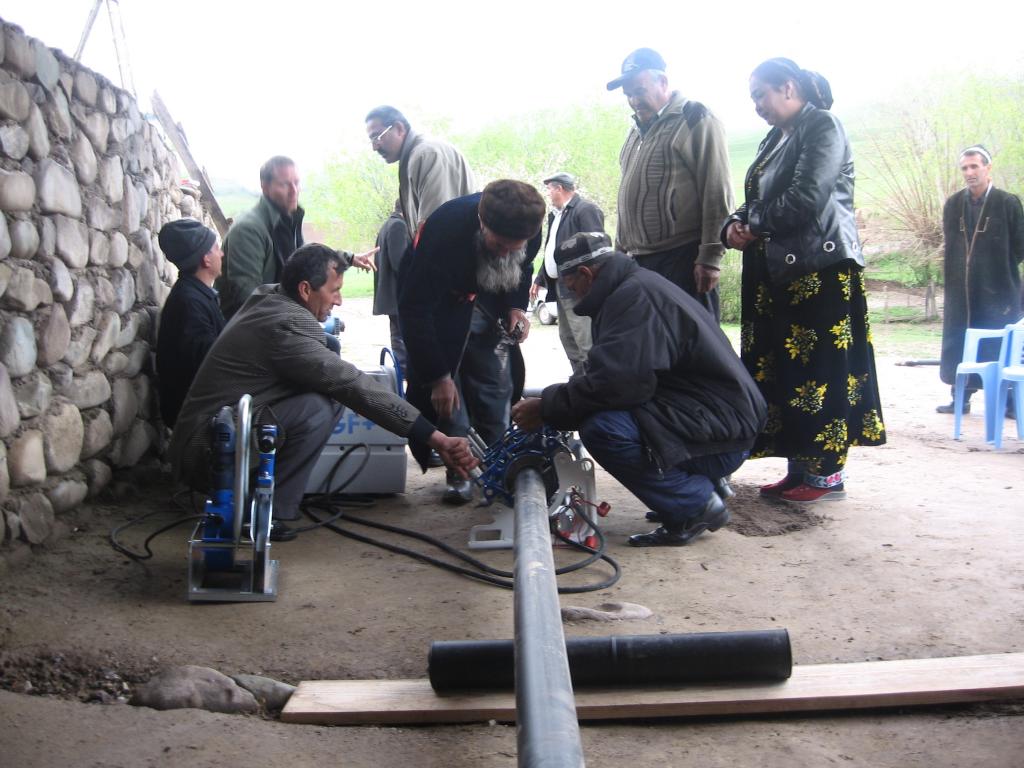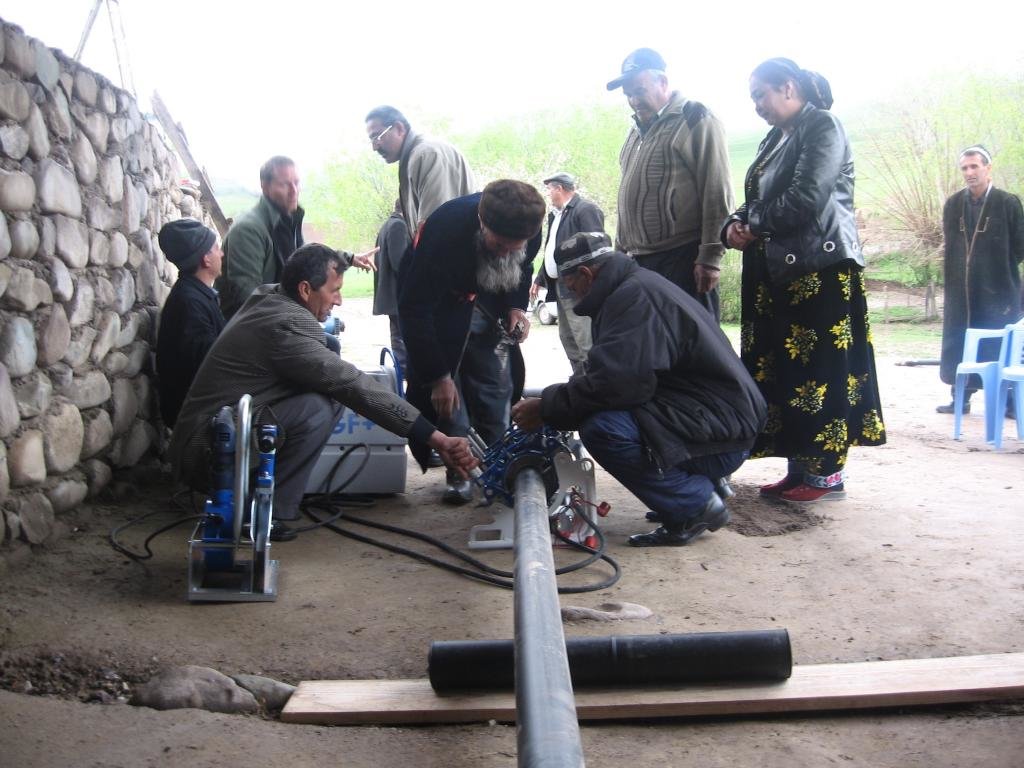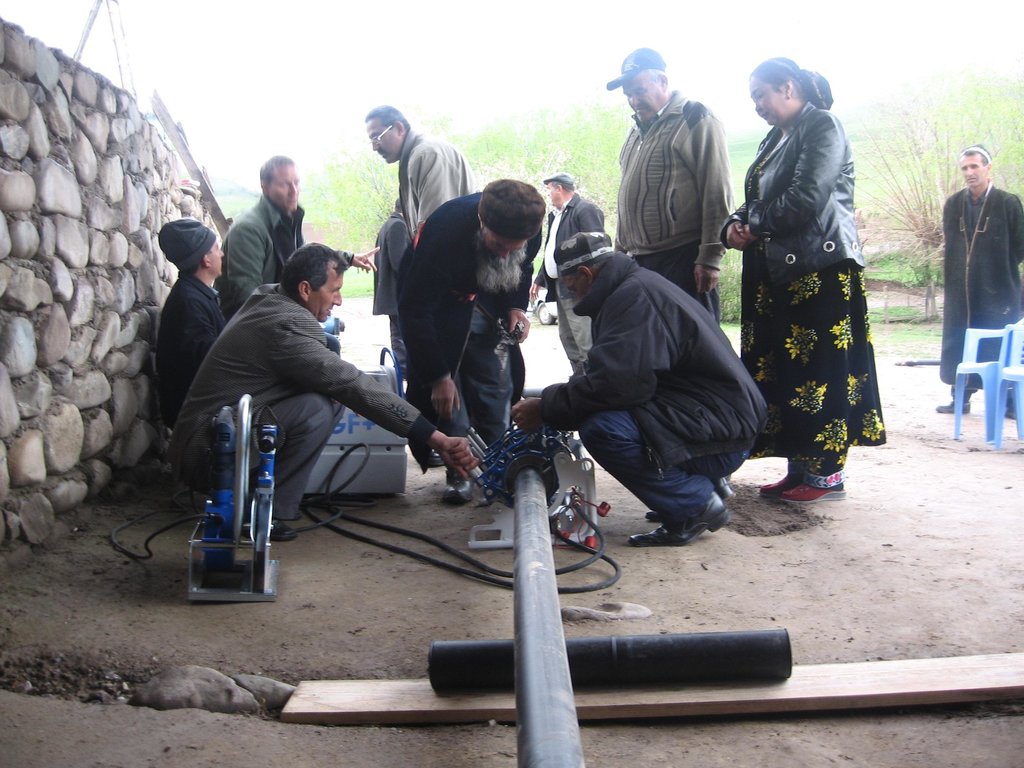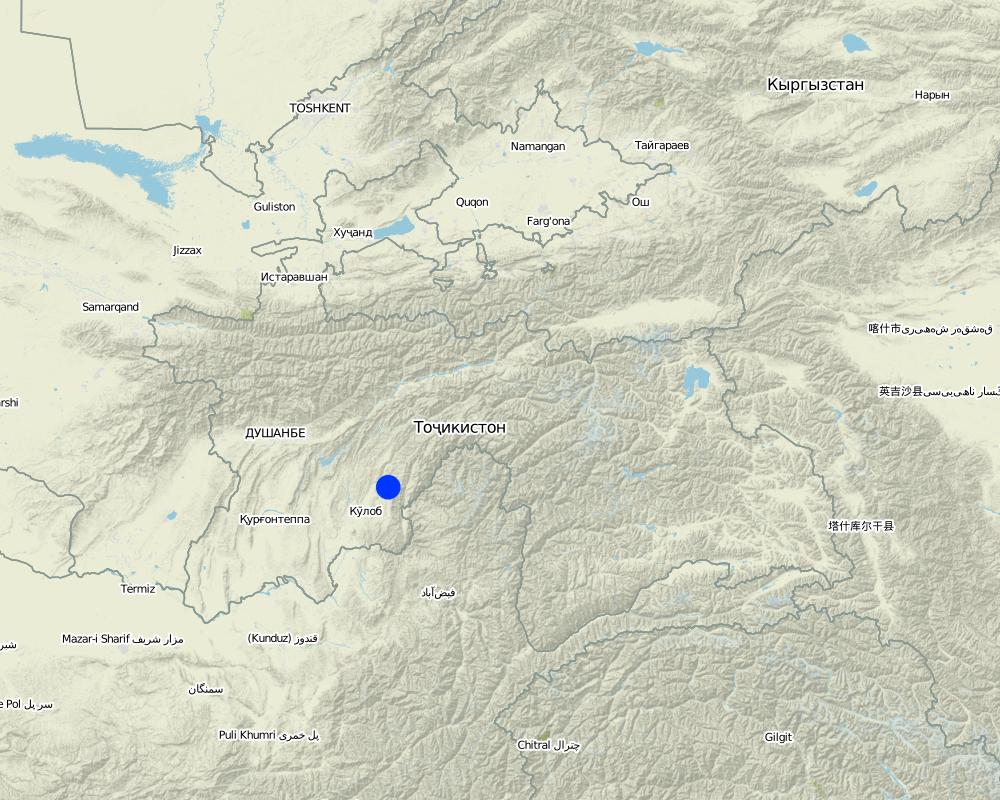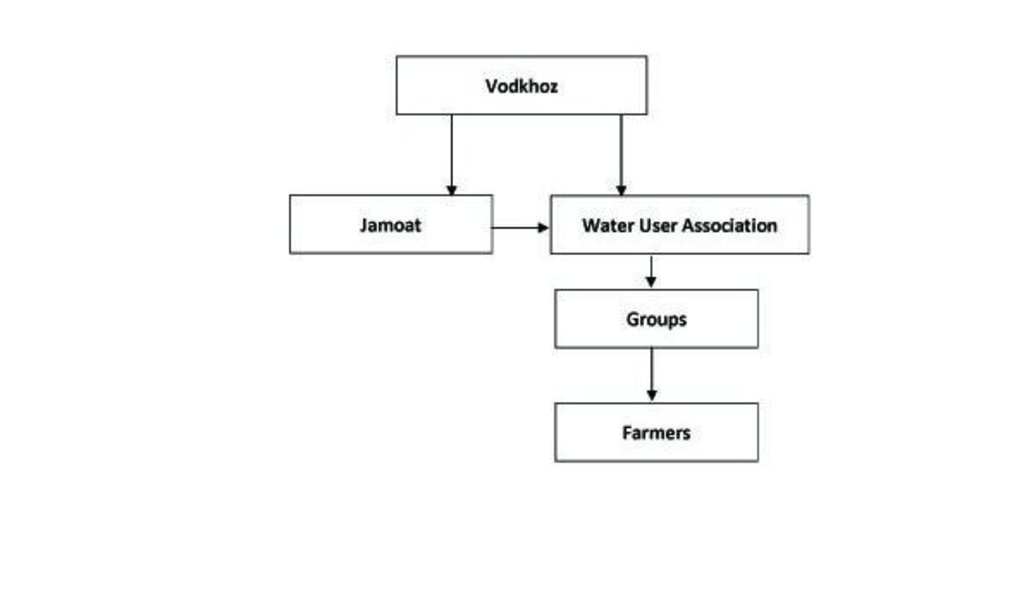Water User Association [Таджикистан]
- Создание:
- Обновить:
- Составитель: Sa'dy Odinashoev
- Редактор: –
- Рецензент: David Streiff
Ассотсиатсияи Истифодабарандагони Об
approaches_2458 - Таджикистан
Просмотреть разделы
Развернуть все Свернуть все1. Общая информация
1.2 Контактные данные специалистов и организаций, участвующих в описании и оценке Подхода
землепользователь:
Kassirov Gayur
WUA
Таджикистан
Название организации (-ий), содействовавших документированию/оценке Подхода (если применимо)
CARITAS (Switzerland) - Швейцария1.3 Условия, регламентирующие использование собранных ВОКАТ данных
Составитель и ответственный/-ые специалист(-ы) согласны с условиями, регламентирующими использование собранных ВОКАТ данных:
Да
2. Описание Подхода УЗП
2.1 Краткое описание Подхода
Management and control of the water distribution, maintenance of the infrastructure and water conflict resolution by the locally organized association
2.2 Подробное описание Подхода
Подробное описание Подхода:
Aims / objectives: Under the National land reform of the Republic of Tajikistan, land resources, which used to belong to kolkhozes and sovkhozes, were distributed to individual households. Such division had two consequences, on the one hand, villagers were given opportunity to develop the land privately as an income-generating source, and on the other hand, it intensified the conflicts over water. The government was not capable to solve the disputes over water and manage the water resources sustainably because of lack of finances and lack of staff. A water users association was created with the aim to replace the former Soviet water management system and to ensure systematic and timely distribution of irrigation water and maintenance, as well as to improve the infrastructure.
Methods: This approach involves thee different actors: association members (water users), the association and the government. The association members have to stick to certain conditions in order to join, namely, they have to pay annual membership fees and water taxes fixed by the government. Government, on its turn, ensures uninterrupted supply of the agreed amount of water and the association is responsible for the control and equal water distribution and all related technical works.
Stages of implementation: Steps involved in creation of the water users association.
1) Local leaders met with representatives of Vodhoz (local state agency, regulating water resources) to discuss creation of an independent association with a full mandate over irrigation water management; 2) Leaders organized a general meeting with people of 5 villages in Muminabad district to inform them about the role and importance of establishing a locally based association and discuss conditions for its membership; 3) Charter of the association was developed, 5 leaders representing villages were elected and the amount of a membership fee was agreed upon; 4) The association was registered as a legal entity; 5) Needed amount of water per growing season was calculated and agreed upon; 5) The Leaders (of association?) and Vodvoz concluded an agreement, according to which, Vodhoz is obliged to provide the required amount of water and the association leaders agree to collect the determined fees for water from the water users and to deliver it on time to Vodvoz.
Role of stakeholders: The role of the three main stakeholders (Vodhoz, association and water users) is to follow the rules of the association. There is a strong element of trust among the association and its members.
2.3 Фотографии, иллюстрирующие Подход
2.5 Страна/ регион/ место, где применялся Подход
Страна:
Таджикистан
Административная единица (Район/Область):
Khatlon
Более точная привязка места:
Muminabad
Комментарии:
270 ha
Map
×2.6 Даты начала и окончания реализации Подхода
Год начала реализации:
2010
2.7 Тип Подхода
- недавняя местная инициатива/ инновация
2.8 Каковы цели/ задачи Подхода
The Approach focused mainly on SLM with other activities (regulation of water distribution, water conservation, conflict resolution)
To establish a responsible body, recognized by the government and accepted by the local people, to manage water related issues and to maintain as well as to improve conditions of the infrastructure in the local level.
The SLM Approach addressed the following problems: The approach is addressing the problem connected with the use of the water resource. Incapability of the government to manage waters on the village level resulted in conflicts over water use, misusage of water and abundance of the infrastructure. This condition had a direct effect to productivity and to food security as a consequence.
2.9 Условия содействующие применению Технологии/ Технологий в рамках Подхода или затрудняющие его
Наличие/ доступность финансовых ресурсов и услуг
- затрудняют
No funds available to maintain the infrastructure
Treatment through the SLM Approach: Annual membership fees
Институциональные условия
- затрудняют
No strong and effective mechanism to regulate irrigation water resources at the local level.
Treatment through the SLM Approach: Establishment of the water users association at the local level and respresented by local people.
Нормативно-правовая база (землевладение, права на земле- и водопользование)
- затрудняют
Unclear situation with regard to water use rights and obligations.
Treatment through the SLM Approach: The condition that association was represented by the local leaders enlarged the trust among the population. During the general meetings local leaders of the association explained for what villages are paying and where money would be invested.
3. Участие и распределение ролей заинтересованных сторон
3.1 Заинтересованные стороны, участвующие в реализации Подхода и их роли
- местные землепользователи/ местные сообщества
Association leaders
- эксперты по УЗП/ сельскому хозяйству
- государственные власти (отвечающие за планирование или принятие решений)
Water Agency/VODHOZ
Если участвовало несколько заинтересованных сторон, назовите ведущую организацию:
Association leaders
3.2 Участие местных землепользователей/ местных сообществ на разных стадиях реализации Подхода
| Участие местных землепользователей/ местных сообществ | Перечислите участников и опишите их вовлеченность | |
|---|---|---|
| инициирование/ мотивация | интерактивное | It was members of the local community, who thought of the idea and they approached the local water agency. |
| планирование | интерактивное | Local leaders organized the meeting where all interested villagers participated. |
| выполнение | внешняя поддержка | Implementation was entirely through the local community. |
| мониторинг/ оценка | нет | |
| Research | нет |
3.3 Схема реализации (если имеется)
Описание:
Organizational chart showing the establishment set up of the Water User Association
Автор:
Sady Odinashoev
3.4 Принятие решений по выбору Технологии/ Технологий УЗП
Укажите, кто принимал решение по выбору применяемой Технологии/ Технологий:
- исключительно землепользователи (по собственной инициативе)
Поясните:
Decisions on the method of implementing the SLM Technology were made by by land users* alone (self-initiative / bottom-up)
4. Техническая поддержка, повышение компетенций и управление знаниями
4.1 Повышение компетенций/ обучение
Проводилось ли обучение землепользователей/ других заинтересованных лиц?
Да
Укажите, кто проходил обучение:
- землепользователи
- местный персонал/консультанты
Тип обучения:
- в ходе работы
- общие собрания
- курсы
4.2 Консультационные услуги
Есть ли у землепользователей возможность получать консультации?
Нет
4.3 Институциональная (организационная) поддержка
В ходе реализации Подхода были ли организованы новые институциональные структуры или поддержаны уже существующие?
- да, существенно
Укажите уровень, на котором структуры были укреплены или вновь созданы:
- местные
Укажите тип поддержки:
- финансовая
- повышение компетенций/ обучение
- оборудование
4.4 Мониторинг и оценка
Являются ли мониторинг и оценка частью Подхода?
Да
Комментарии:
technical aspects were regular monitored by project staff, government, land users through observations; indicators: None
economic / production aspects were regular monitored by project staff, government, land users through observations; indicators: None
area treated aspects were regular monitored by project staff, government, land users through observations; indicators: None
area treated aspects were regular monitored by project staff, government, land users through measurements; indicators: None
management of Approach aspects were regular monitored by project staff, government, land users through observations; indicators: None
management of Approach aspects were None monitored by project staff, government, land users through measurements; indicators: None
There were several changes in the Approach as a result of monitoring and evaluation: None
4.5 Научные исследования
Были ли научные исследования частью Подхода?
Нет
5. Финансирование и внешняя материальная поддержка
5.1 Годовой бюджет мероприятий по УЗП в рамках Подхода
Если точный годовой бюжет неизвестен, укажите примерный диапазон затрат:
- 10000-100000
Комментарий (например, основные источники финансирования/ ключевые доноры):
Approach costs were met by the following donors: international: 80.0%; local government (district, county, municipality, village etc): 10.0%; local community / land user(s): 10.0%
5.2 Финансирование и внешняя материальная поддержка, предоставляемая землепользователям
Предоставлялась ли землепользователям финансовая/ материальная поддержка для применения Технологии /Технологий?
Нет
5.3 Субсидии на отдельные затраты (включая оплату труда)
- оборудование
| Укажите, какие ресурсы были субсидированы | В какой степени | Опишите субсидии подробнее |
|---|---|---|
| инвентарь/ инструменты | профинансированы полностью | |
- строительные материалы
| Укажите, какие ресурсы были субсидированы | В какой степени | Опишите субсидии подробнее |
|---|---|---|
| камень | профинансированы полностью | |
| древесина | профинансированы полностью | |
- инфраструктура
| Укажите, какие ресурсы были субсидированы | В какой степени | Опишите субсидии подробнее |
|---|---|---|
| дороги | профинансированы полностью | |
| школы | профинансированы полностью | |
Если труд землепользователя был существенным вкладом, укажите, был ли этот вклад:
- за денежное вознаграждение
5.4 Кредитование
Предоставлялись ли в рамках Подхода кредиты на мероприятия УЗП?
Нет
6. Анализ влияния и заключительные положения
6.1 Влияние Подхода
Сумел ли Подход помочь землепользователям внедрить и поддерживать технологии УЗП?
- Нет
- Да, немного
- Да, умеренно
- Да, существенно
Increase of yield. Farmers receive more yield from the small plots.
Сумел ли Подход расширить возможности социально и экономически уязвимых групп?
- Нет
- Да, немного
- Да, умеренно
- Да, существенно
Did other land users / projects adopt the Approach?
- Нет
- Да, немного
- Да, умеренно
- Да, существенно
Did the Approach lead to improved livelihoods / human well-being?
- Нет
- Да, немного
- Да, умеренно
- Да, существенно
Since the certain mechanism of water management was developed, water disputes significantly reduced and productivity increased
Did the Approach help to alleviate poverty?
- Нет
- Да, немного
- Да, умеренно
- Да, существенно
6.2 Основные причины, побуждающие землепользователей внедрять УЗП
- рост продуктивности
to improve crop production
- рост прибыли (доходности) и рентабельности
to improve yield
- снижение объёма работ
- экологическая сознательность
- well-being and livelihoods improvement
improvement of villagers' well-being, whose main income comes from the agriculture
6.3 Долгосрочная устойчивость мероприятий в рамках Подхода
Могут ли землепользователи самостоятельно (без внешней поддержки) продолжать применение того, что было реализовано в рамках Подхода?
- да
6.4 Сильные стороны/ преимущества Подхода
| Сильные стороны/ преимущества/ возможности по мнению землепользователей |
|---|
| Water management through such associations is of states' interest as well, and therefore state supports minilar initiatives. |
| Conflict resolution: Association leaders act as a conflict resolving body and due to their respectful position in the community, they are able to avoid serious conflicts. |
| Transparency: Association is initiated and regulated by the local leaders, therefore there is much more trust on them among water users. |
6.5 Слабые стороны/ недостатки Подхода и пути их преодоления
| Слабые стороны/ недостатки/ риски по мнению землепользователей | Возможные пути их преодоления/снижения? |
|---|---|
| sometimes it is difficult to collect money from water users. | |
| membership fee is too low and not enough to make significant investment to maintanence of the infrstructure. |
7. Справочные материалы и ссылки
7.1 Методы сбора/источники информации
- выезды на места, полевые обследования
- опросы землепользователей
Ссылки и модули
Развернуть все Свернуть всеСсылки
Нет ссылок
Модули
Нет модулей


